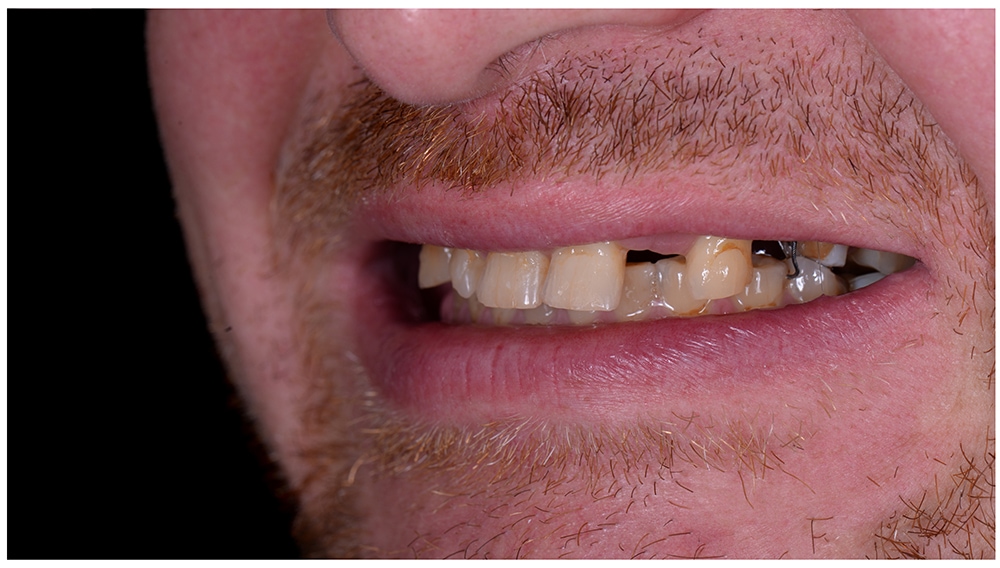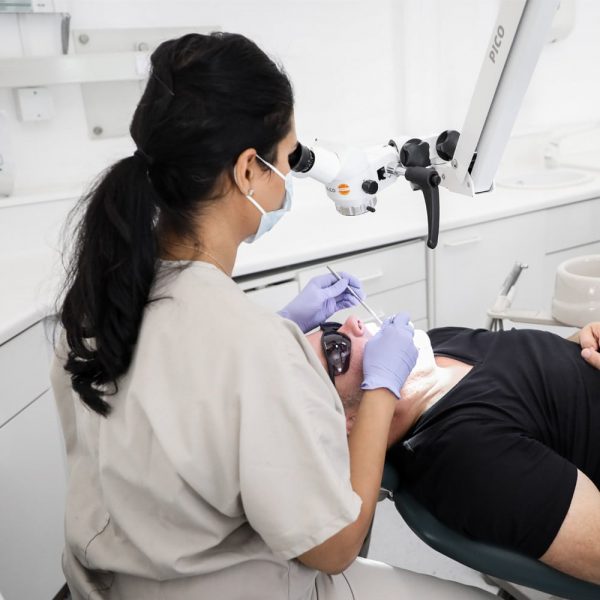Gum disease (aka periodontal disease) affects millions worldwide and can lead to serious consequences if left untreated. Luckily, there’s hope. Gum disease can be controlled and treated effectively with proper knowledge and care.
In this webpage, we will guide you through the basics of gum disease - what causes it, how to recognise its symptoms, the different stages of progression, and the non-surgical and surgical treatments available. We’ll also explore the link between gum disease and other medical conditions while providing tips on maintaining healthy gums for life.
So grab a seat, and let’s dive into the world of gum disease together!
Periodontal Disease: Key Takeaways
- Gum disease can lead to serious consequences if left untreated and is caused by bacterial infection.
- Lifestyle factors such as smoking, hormonal changes, certain illnesses, and genetics can all impact the risk of gum disease.
- Gum disease stages are classified based on severity and can be identified through symptoms such as bleeding gums, inflammation, and bad breath.
- Preventing gum disease is crucial for overall well-being and includes proper daily brushing, healthy lifestyle choices, and regular professional cleanings.
Gum Disease Causes & Risk Factors
Gum disease is an umbrella term for a group of inflammatory conditions triggered by bacteria destroying the tissues surrounding the teeth. But don’t worry - prevention is key!
By following some simple oral hygiene tips and being aware of lifestyle factors that increase your risk for gum disease, you can keep your gums healthy and avoid this common problem. First and foremost, maintaining good oral hygiene is essential for preventing gum disease.
Brushing twice daily with an electric toothbrush and fluoride toothpaste is crucial, as is cleaning between your teeth daily. Regular dental checkups are also important to catch any signs of gum disease early on.
Lifestyle factors such as smoking, hormonal changes, certain illnesses, and genetics can all impact your risk of developing gum disease. You can keep your gums in top shape by staying informed about these factors and minimising their effects on your health. Complete the form below if you are concerned about any gum disease symptoms.
Periodontitis is a gum disease. It is a chronic inflammatory disease that is triggered by bacterial microorganisms and involves a severe chronic inflammation that causes the destruction of the tooth-supporting apparatus and can lead to tooth loss. It can also lead to other health problems.
What is Periodontitis?
Risk factors include smoking effects, genetic predisposition, hormonal changes, poor oral hygiene, and diabetes connection are all potential risk factors for gum disease. Smoking can significantly increase the likelihood of developing gum disease by impairing blood flow to the gums and weakening the immune system’s ability to fight infection. Genetic predisposition may also play a role in gum disease development, making some individuals more susceptible than others.
Hormonal changes during puberty, pregnancy, and menopause can also increase the risk of developing gum disease due to fluctuations in hormone levels that affect the body’s response to bacteria. Poor oral hygiene habits, such as infrequent brushing or flossing, can lead to plaque buildup on teeth and gums, which can eventually cause inflammation and infection.
Additionally, people with diabetes are at an increased risk of developing gum disease due to overactive immune function. Recognising these potential risk factors is crucial in taking preventative measures against gum disease before progressing further into more severe stages.
Gum Disease Signs and Symptoms
Symptoms include bleeding or swollen gums, bad breath, or loose teeth. Here are some specific signs to look out for:
- Gums that are red, inflamed, or tender to the touch
- Receding gums that make your teeth appear longer than they used to
- Pus coming from between your teeth and gums
If you notice any of these symptoms, taking action immediately is important. Complete the form below to start taking action. Prevention tips include practising good oral hygiene at home by brushing twice daily and flossing daily, making lifestyle changes like quitting smoking or losing weight if necessary, and getting regular professional cleanings from a dental hygienist.
By taking care of your gum health now, you can prevent the progression of gum disease into more serious stages like periodontitis.
To learn more about the stages of gum disease, from gingivitis to periodontitis, continue reading in the next section…
Gum Disease: Stages and Types.
Gum disease stages are classified based on severity and can be identified through symptoms such as bleeding gums, inflammation, and bad breath. It is important to detect gum disease early as it can progress rapidly if left untreated.
To help you understand the different stages of gum disease, take a look at this table:
| Stage |
Description |
Symptoms |
Treatment |
| Gingivitis |
Mild inflammation of the gums caused by plaque buildup. |
Bleeding gums, swollen or red gums. |
Professional cleaning improved oral hygiene. |
| Stage II Periodontitis |
The early stage is when gums start to pull away from teeth. |
Sensitive or tender teeth, receding gums. |
Scaling and root planing |
| Stage III Periodontitis |
Continued loss of bone support around teeth due to bacteria buildup. |
Bad breath, pus between teeth and gums. |
Surgery or grafts may be necessary. |
| Stage IV Periodontitis |
Severe damage to tooth-supporting tissues requires immediate intervention before tooth loss occurs. |
Loosening teeth, severe pain when chewing. |
Surgical treatments such as flap surgery or root canal treatment and dental implants |
Prevention is key to avoiding gum disease altogether. Practicing good oral hygiene habits such as brushing twice daily for two minutes each time and flossing daily can greatly reduce your risk of developing gum disease. Regular dental check-ups are also essential in identifying potential issues early on that could lead to gum disease. Making lifestyle changes such as quitting smoking and reducing alcohol consumption can also positively impact your oral health.
Now that you know about the different stages of gum disease and how to prevent it from progressing through good oral hygiene practices and lifestyle changes, let’s explore non-surgical treatments to nurture your gums back to health.
Non-Surgical Gum Disease Treatments
Non-surgical treatments significantly improve gum inflammation. These tend to be successful in Stage II disease. Options include:
- Deep cleaning with a dental hygienist. This used to be known as scaling and root planing. It involves removing plaque and tartar buildup from the teeth and beneath the gum line. The dentist or dental hygienist uses specialised tools to scrape away the deposits and smooth the tooth roots to prevent further bacterial growth.
- Antibiotics: In some rare cases, we may prescribe antibiotics to control the bacterial infection. These can be taken orally but must be taken in conjunction with deep cleaning done by an expert. Antibiotics help eliminate the harmful bacteria and reduce inflammation.
- Probiotic supplements: Taking probiotics can help balance out the bacteria in your mouth, reducing harmful bacteria and promoting healthy ones.
- Dental Hygienist Maintenance: Good oral hygiene practices at home, such as brushing with an oral b electric toothbrush twice daily and cleaning between teeth with interdental brushes daily.
- Lifestyle changes: Quitting smoking, twice daily brushing and managing underlying health conditions like diabetes can improve gum health and aid in treating gum disease.
When considering options for treating severe periodontitis, surgical interventions may be necessary to address severe cases of periodontitis. Non-surgical treatments like scaling and root planing can only do so much when the pockets exceed 4mm.
Surgical Treatment of Gum Disease.
Surgical treatment is usually required for Stage III and Stage IV disease where non-surgical treatment is unsuccessful. Tissue regeneration techniques involve using biocompatible materials to stimulate the growth of new bone and soft tissue in areas affected by periodontal disease. The only issue with surgical treatment for severe periodontal disease is that it tends to result in severe gum recession.
Peri-implantitis treatment may be necessary when implants become infected due to poor oral hygiene or other factors. In such cases, bone grafting or gum grafting may be required to restore the damaged tissues surrounding the implant. When it comes to treating severe gum diseases, our team at London Dental Specialists will work closely with you to determine which surgical intervention is right for your unique needs and goals. Complete the form below today.
As important as treating gum disease is, it’s also essential to note that it has been linked with other medical conditions such as heart disease and diabetes. We’ll explore this further in the next section about ‘gum disease and other medical diseases.
Gum Disease and Other Medical Diseases
It’s fascinating to note the association between gum disease and a higher risk of heart disease, with inflammation being the likely culprit. This connection may be due to the bacteria and inflammation from gum disease spreading throughout the body, causing damage to the arteries and increasing the risk of heart attacks and strokes.
But did you know gum disease is also connected to other medical conditions such as diabetes, pregnancy complications, arthritis, and respiratory diseases? People with diabetes are more likely to have gum disease because high blood sugar levels weaken their immune system’s ability to fight off infections. Pregnant women with gum disease are at a greater risk for premature birth and low birth weight babies. And those with arthritis or respiratory diseases may worsen their symptoms with untreated gum disease.
Preventing gum disease is crucial for not only your oral health but your overall well-being as well. By maintaining good oral hygiene practices like brushing twice a day, flossing daily, and visiting your dentist regularly for cleanings, you can keep your gums healthy and reduce your risk for these systemic diseases.
Your guide to maintaining healthy gums starts with caring for them daily!
Gum Disease Prevention: Your Guide to Maintaining Healthy Gums
Excellent oral hygiene is crucial for treating gum diseases (gingivitis and periodontitis). Research shows gum disease has been linked to several medical conditions, such as heart disease, diabetes, pregnancy complications, arthritis, and respiratory diseases. To prevent gum disease and its associated health risks, it’s important to take preventive measures, including proper oral hygiene practices and healthy lifestyle choices.
Here are some ways you can maintain healthy gums:
-
Practice good oral hygiene by brushing your teeth at least twice daily for two minutes with an electric toothbrush and using interdental brushes to clean between your teeth daily.
-
Adopt a healthy diet that is low in sugar and processed foods, as they can contribute to the development of gum disease.
-
Schedule regular professional cleanings with your dentist or hygienist to remove tartar buildup and detect any signs of early gum disease.
Following these preventive measures can keep your gums healthy and reduce your risk of developing serious health conditions. Complete the form below to start taking action.

















